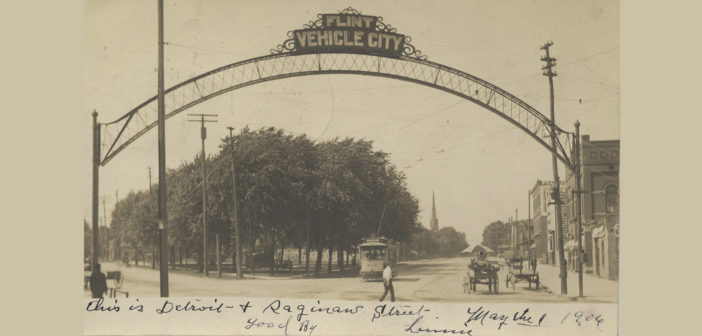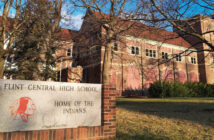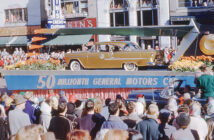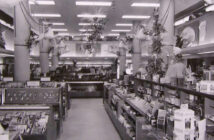The air was clean and filled with the sound of birds, the trees gently swayed with the breeze and the reflection of the sun turned the face of the river to gold. The world was beautiful and serene. Jacob Smith, a Canada-born fur trader, surveyed the land as he approached Peiconigowink – “the river of the fire stone” – and saw a place of immense opportunity. At the southern most bend, in a place dubbed the “grand traverse” years before by French fur traders, Smith decided to stop his wandering. He began to lay the foundation for a new trading post, not knowing he was laying the foundation for something much bigger.
In 1811, Smith’s trading post alongside the Flint River was the beginning of one of the nation’s most resilient and inspiring cities. The City of Flint has enjoyed both triumph and misery. It has gone from a shining example of what the United States can be, to a tragic example of what it could become, to the icon of perseverance and pride that it is today. The city has produced heroes of commerce, business, manufacturing, solidarity, athletics, the arts and philanthropy. Flint’s fortune has ebbed and flowed like that of its namesake and like its namesake, it is forever moving forward, unstoppable. Since 1811, Flint has been a great piece of the fabric of our nation. This is its story …
1900-04 Flint Gets Mobile
In 1900, before a crowd of approximately 10,000 spectators, Judge Charles Wisner drove Flint’s first horseless carriage down Saginaw St. in the Labor Day Parade. The judge beamed as he rolled down the road to the “oohs” and “aahhs” of the city population. The carriage moved along brilliantly as if it could go on perpetually, never flagging or failing. After a wild and successful ride, the machine, much to the Judge’s chagrin, began sputtering and eventually came to a stop. Flint’s first horseless carriage had stalled.
In his day, Judge Wisner was a man of considerable genius. Forever tinkering with this and that, he eventually would come to hold five patents: a minnow trap, a newly-fashioned fishing reel and, true to the spirit of the city, three patents involving the auto industry. (Wisner’s workshop still stands in Genesee’s Crossroads Village at the corner of Main St.) His main contribution to the Vehicle City, however, was that fateful ride in the 1900 Labor Day Parade. His ride lasted just long enough to catch the eye of a man who would be instrumental in auto-manufacturing in Flint and throughout the world: William “Billy” Durant. Wisner and Durant struck up a friendship and although Durant wouldn’t purchase the patent for Wisner’s automobile (he found them a little dangerous at the time), the mere idea of the horseless carriage would leave its mark.
Billy Durant and J. Dallas Dort of the Durant-Dort Carriage Company (formerly the Flint Road Cart Company) were always at the forefront of innovation, and when electricity was brought to Flint in 1901, the Carriage Factory was the second business to plug in – just behind one of the first newspapers in the city, the Flint Daily Globe. The manufacturing process we know today had begun. The road was paved for the future of the city and many, both inside and out, seized the opportunity.
In late 1903, Flint Wagon Works, a rival of Durant and Dort, made a move that would push the city fully into the automobile craze. President James H. Whiting made the decision to purchase the fledgling Buick Motor Company to build engines for farm equipment. David Dunbar Buick and his chief engineer, Walter Marr, followed the company. Upon arriving, they immediately asked Whiting to manufacture the first Buick motorcar. Whiting agreed. In 1904, Walter Marr and Thomas Buick (David’s son) drove to Detroit and back in the first manufactured Buick. Whiting was hooked and Flint went into auto production for the first time.
Whiting quickly became frustrated with Buick – production of the successful automobile was extremely slow and costly. Whiting looked for help and the secretary of the Durant-Dort Carriage Company, Fred Aldritch, put him in touch with Billy Durant. Toward the tail-end of 1904, Durant was in the driver’s seat at Buick.
It is made known to the state that Flint is a city of high ideals …
1905-09 It’s a Golden Jubilee!
What a celebration! On a beautiful day in June, the majority of Flint’s residents lined Saginaw St. to celebrate Flint’s 50th year as an official city. Vice President Charles Fairbanks and Flint Mayor David D. Aitken lead the parade, riding in an ornate carriage. Fairbanks stood and waved to the people as he passed. Buildings were decorated with elegant red, white and blue bunting and flags. The crowd waved to the parading Flint band, mail-carriers and vehicle workers. Next came the Golden Jubilee parade floats depicting the evolution of the vehicle. The first float featured a large globe attached to a wheel, and as the wheel turned, the globe revolved, indicating the part the vehicle industry played in “making the world go-round.” The final float depicted the most extravagant of horseless carriages.
Immediately following the parade, Vice President Fairbanks laid the cornerstone of the new Federal building. The momentous day’s festivities continued as two new street arches were erected, each proclaiming Flint as “Vehicle City” for the first time. The Golden Jubilee was not only a celebration for the citizens, it also proclaimed to the world that Flint was a city like no other.
“It is made known to the state that Flint is a city of high ideals, that it is ambitious not only to take a leading place in the industrial and commercial world, but that it is seeking to develop and foster a higher type of intellectual, moral and patriotic citizenship, that it is endeavoring to establish and perpetuate institutions and influences alongside of its industrial and commercial enterprises that will preserve and strengthen its reputation of a city of homes, schools and churches. It thus drew the attention of the best class of men and women, the kind who make a city prosperous in the highest sense.”
-From the program of the Golden Jubilee of Flint (1905).
-From the program of the Golden Jubilee of Flint (1905).
The Golden Jubilee marked a point of no return for Flint. The city so wholeheartedly embraced the “Vehicle City” moniker that it would be married to the industry until present day. Truly, the two were engaged the January before the Jubilee festivities, when Billy Durant, David Dunbar Buick and Walter Marr returned from an extremely prosperous trip to New York, wherein it is believed that they sold no less than 1,000 Buick cars. Slightly later that year, James Parkhill erected (with great foresight) the city’s first gas station at the current site of The Durant. The city’s growth really began to pick up speed.
To help keep up with demand for Buick cars, workers came from all over the nation and beyond. From Canada came four salvationist bandsmen and soon, others. In no time, the Salvation Army Flint Citadel Band was formed and could be heard by all citizens of Flint up to the present day. In 1906, Horace C. Spencer and J. Dallas Dort hired a landscape architect from Boston, MA by the name of Warren Manning, to develop a boulevard and park system. Eventually, a total of 115 acres would be designated park lands in the City of Flint.
While Dort was busy building Flint’s park system, Durant was living up to his wily disposition. He was using his time to convince Charles Stewart Mott, President of the Weston-Mott Company, to bring his business to Flint from New York. It is unknown what Durant said or promised to Mott; but whatever it was, it worked. In 1907, Mott moved his company to Flint and shortly thereafter, merged with the Buick Motor Company. During this time, the auto industry was booming and everyone was coming to try their hand at motorized fortune.
Durant had a plan to get a jump on the competition: he would merge as much as he could under one company. So, in 1908, he created a holding company entitled General Motors (GM) with the help of a few partners (including Mott). After getting the company charter authorized in New Jersey, Durant wasted no time in making acquisitions. He immediately purchased Oldsmobile in Lansing, and during the next two years would also acquire Cadillac, Oakland (Pontiac), several truck companies and others. (He made an offer to purchase Ford for eight million dollars, but bankers turned down the loan.) GM also purchased a company that moved to Flint from Boston. A.C. Sparkplug was owned by Albert Champion, who moved the business to Flint in 1908 and by 1909 was persuaded by Durant to become part of GM. A.C. Sparkplug operated in Flint until its closing in 2003. Along with Champion, Flint found itself at the center of automobile businessmen and enthusiasts. Sam Wey opened shop and created the Wey car, noted for being the first taxicab. James Whiting tried his hand with the Whiting automobile (a predecessor of Chevrolet). William Paterson began building the Paterson Automobile and Randolph trucks went into production.
While the auto industry was staking its claim, Flint’s medical profession was growing. A junk business owner named James J. Hurley donated land for the construction of a hospital that would bear his name and become one of the country’s leading trauma centers – Hurley Hospital. By 1910, Flint’s population would double to approximately 38,000 people and the city would continue to flourish. At the tail-end of a prosperous decade for Flint, a new City Hall was erected that would stand for more than 40 years.
1910-14 Intellect, Ability & Perseverance
In 1910, J. Dallas Dort and some prominent Flint men got together and contributed roughly $500 dollars each for a new project. They acquired a farm near Atlas and started the Flint Golf Club. Dort designed the first nine holes, himself. The course was only accessible at the time via the Detroit Inter-Urban Railway. The railway has since been abandoned, but the railway banks are still visible from the eighth green on the current Atlas Valley Country Club course.
While Dort was busy practicing his backswing, good ol’ Billy Durant got himself into a bit of trouble. He had over-extended himself with numerous business purchases and bankers finally cut him off and took over GM. Durant couldn’t be stopped, however. He immediately formed an alliance with Buick race car driver, Louis Chevrolet, and started the Chevrolet Motor Car Company in 1911. Chevrolet joined the Dalton Automobile Company, started by Huber Dalton, as Flint’s two newest vehicle enterprises.
A block from Saginaw St., a new church was being built with Father Michael J. Comerford at the head. St. Michael’s Church was established on Beach St., complete with a school and rectory. A little further south down Saginaw, the Free Masons were busy constructing a temple of their own. Meanwhile, a quiet inventor in Flint by the name of Lloyd G. Copeman was making a splash with Copeman Electric Stove Company. During its small run (two years), Copeman would receive patents for a rubber ice cube tray, electric toaster, bird-feeding equipment and a pressure system for greasing automobile bearings.
In 1912, Flint welcomed ex-president Teddy Roosevelt to the growing and bustling city. He came to tour the magnificent Buick Factory. An educator from Kansas was also visiting the city at the time. Eldon Baker traveled to Flint looking to construct a business university in the growing city. He soon purchased the Flint Business University, already established. He quickly re-branded the school as Baker Business University, which would become Baker College. C.S. Mott organized and became President of the YMCA Flint chapter.
Ever the energetic entrepreneur, Billy Durant was at it again in 1914 when he formed the Monroe Motor Company with R. F. Monroe from Pontiac. The two worked together on both Monroe and Chevrolet vehicles in the Chevrolet Factory. At this point, Flint truly was the vehicle city it claimed to be – cranking out Buick, Monroe, Chevrolet, Dalton, Wey, Whiting and Paterson automobiles, as well as trucks and carriages. Retail shops and gas stations lined Saginaw Street while coal mining, lumber companies, mills and manufacturing was booming.
1915-19 Spectacle & Triumph
It was on a clear summer day that citizens of Flint would get a treat. Above them in the sky soared G. Russell Clark of Flint on the wing of a single-seat plane flown by O.E. Williams. It was the first flight over the city. Flint’s populace had grown to roughly 85,000 (only 11,000 less than current day) and with that came artistry and exuberance. The city would see the arrival of prominent theatres, artists … and a human fly.
Immigrants were flooding into the city from all parts of the world looking for jobs and fortune and in 1916, one such immigrant immediately made his mark on the city. Albert Koegel had learned meat-cutting and processing techniques in Germany and soon set up Koegel Meat Company on Kearsley St. He had immediate success with the large and hardworking population. The streets were packed with people enjoying the many shops during one of the Downtown “Dollar Day” celebrations, when the Durant building was scaled by a man calling himself “The Human Fly.” He made it to the top and the crowd no doubt, exploded with delight.
While The Human Fly (Jack Williams of Kalamazoo) was making headlines out in the sun, Billy Durant and the Chevrolet Motor Company were busy making headlines on the ledger. He had turned Chevrolet into a giant and used that success to buy back into GM. As president, he quickly purchased Fisher Body and Frigidaire and in 1917, merged Chevrolet with GM. Not to be outdone, his old partner, J. Dallas Dort, started up competition in the form of the Dort Automobile, which was produced until 1925.
The year 1917 brought new entertainment to Flint. The Palace Theatre was opened on Kearsley St., down the road from Koegel Meats. It would eventually become the first theatre in the city to show wide-screen movies. Just north of Downtown on Saginaw St., the Regent Theater opened, showing silent films for .07 cents a ticket.
The summer of 1918 was another scene of great celebration. On November 11, WWI ended and a great parade was held. Saginaw St. would once again be the center of attraction for the patrons of Flint. Away from the spectacle, C.S. Mott was putting finishing touches on his lavish mansion which was started two years earlier. He dubbed it Applewood, and it would be a great piece of Flint for the next century and beyond. The YMCA was a hit with the men of the city and soon, the idea for a trade school was put into production there. Led by Albert Sobey, the Flint Institute of Technology was soon established, later to become General Motors Institute (GMI). At an office on Eleventh St., those in need of medical care could find John Wesley Moore, Flint’s first African-American physician.
The nation was motorized and the end of the decade, called for change. The original Saginaw St. arches came down to make way for traffic lights, and Flint was alive with vehicles zooming down roads all over the city. The population hovered just under 100,000 and would soon be pushed over the threshold. In 1919, Durant hired Alfred P. Sloan and Charles F. Kettering to work in a management capacity for GM and was riding high while he attended another large celebration in the city. In July, Flint would hold the “Centennial and Home Festival” in honor of Jacob Smith and his trading post. The future was bright for the citizens and the nation.
The next decade would hold triumphs immeasurable for Flint, its citizens and entrepreneurs. For the ever-hopeful Billy Durant, however, another shock was just behind the horizon.
Other Notable Events Timeline
1900
- Ladies Catholic Benevolent Association organized
- First Church of Christ, Scientist organized
1901
- Flint Factories Mutual Benefit Association organized by J. Dallas Dort
- National League of Veterans & Sons organized
1902
- Doyle Elementary Opened
- Knights of Columbus organized
- Knights of the Maccabees organized
1903
- Sam Rolland became the first black man employed by Buick Factory
1904
- The Great Flint Flood
- Fraternal Order of Eagles organized
1905
- Carnegie Library is built (torn down in 1956)
1906
- Flint Board of Commerce created
1907
- Athletic park near downtown opened
- Daughters of the American Revolution organized
1909
- Loyal Order of Moose organized
1912
- Clark school opened
1914
- Loyal Order of the Elks organized
1916
- The Woman’s Council organized
1917
- Detroit Tigers played against the best of Flint at Athletic Park
1919
- The Flint Knights of Columbus organized
References:
Atwood, E. W. (1905). The book of the Golden Jubilee of Flint, Michigan. Retrieved from: babel.hathitrust.org/cgi/pt?id=mdp.49015003093805;view=1up;seq=4
Durant-Dort Carriage Company. (2018). The beginning Buick. Retrieved from: durantdort.org/The-Beginning-Buick
Flint Citadel Band. (2018). A history of the Salvation Army in Flint, Michigan. Retrieved from: flintcitadelband.org/history.htm
Gustin, L. R. (2008). Billy Durant: Creator of General Motors. University of Michigan Press, Ann Arbor, MI.
Holice, Deb & Clayton. (2002). The history of Genesee County, Michigan.
Retrieved from: usgennet.org/usa/mi/county/lapeer/gen/ch29/parks.html
Kimes, B. R., & Cox, J. H. (2018). Walter L. Marr, Buick’s amazing engineer. Speedreaders.info. Retrieved from: http://speedreaders.info/67-walter_l_marr_by_beverly_rae_kimes_aamp_/
Koegel Meat Company. (n.d.). In Wikepedia. Retrieved from: en.wikipedia.org/wiki/Koegel_Meat_Company
Sharlow, C. (2018). Michigan lawyers in history. Michbar.org. Retrieved from: michbar.org/file/barjournal/article/documents/pdf4article2980.pdf
The Flint Club. (2006). Timeline of Flint. Flinthistory.com. Retrieved from: archive.li/jzTLw








